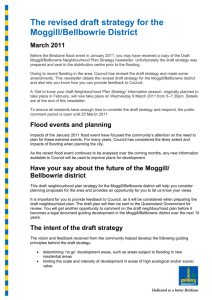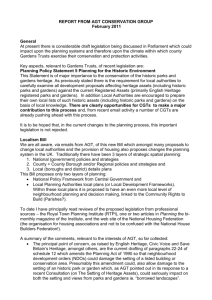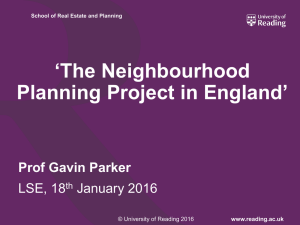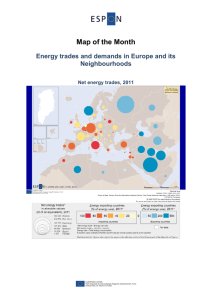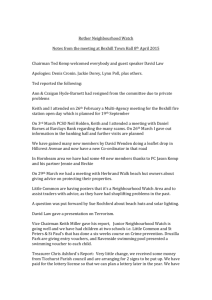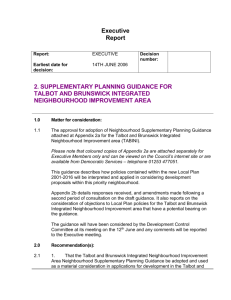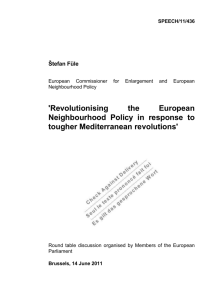Urban Law - workshop notes
advertisement
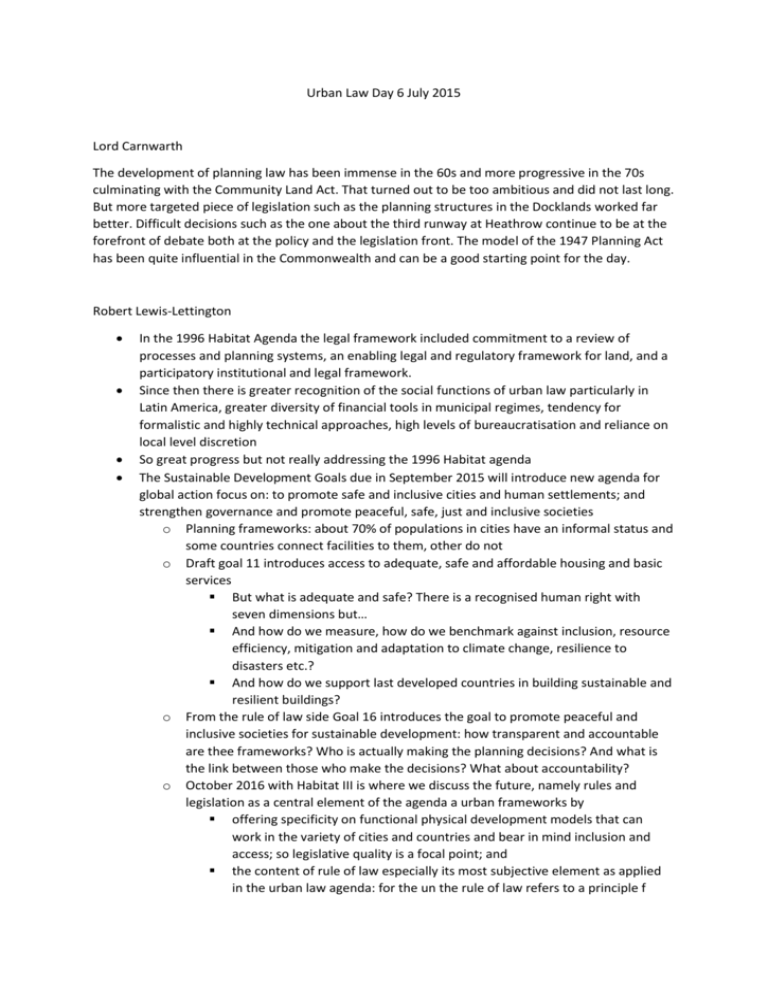
Urban Law Day 6 July 2015 Lord Carnwarth The development of planning law has been immense in the 60s and more progressive in the 70s culminating with the Community Land Act. That turned out to be too ambitious and did not last long. But more targeted piece of legislation such as the planning structures in the Docklands worked far better. Difficult decisions such as the one about the third runway at Heathrow continue to be at the forefront of debate both at the policy and the legislation front. The model of the 1947 Planning Act has been quite influential in the Commonwealth and can be a good starting point for the day. Robert Lewis-Lettington In the 1996 Habitat Agenda the legal framework included commitment to a review of processes and planning systems, an enabling legal and regulatory framework for land, and a participatory institutional and legal framework. Since then there is greater recognition of the social functions of urban law particularly in Latin America, greater diversity of financial tools in municipal regimes, tendency for formalistic and highly technical approaches, high levels of bureaucratisation and reliance on local level discretion So great progress but not really addressing the 1996 Habitat agenda The Sustainable Development Goals due in September 2015 will introduce new agenda for global action focus on: to promote safe and inclusive cities and human settlements; and strengthen governance and promote peaceful, safe, just and inclusive societies o Planning frameworks: about 70% of populations in cities have an informal status and some countries connect facilities to them, other do not o Draft goal 11 introduces access to adequate, safe and affordable housing and basic services But what is adequate and safe? There is a recognised human right with seven dimensions but… And how do we measure, how do we benchmark against inclusion, resource efficiency, mitigation and adaptation to climate change, resilience to disasters etc.? And how do we support last developed countries in building sustainable and resilient buildings? o From the rule of law side Goal 16 introduces the goal to promote peaceful and inclusive societies for sustainable development: how transparent and accountable are thee frameworks? Who is actually making the planning decisions? And what is the link between those who make the decisions? What about accountability? o October 2016 with Habitat III is where we discuss the future, namely rules and legislation as a central element of the agenda a urban frameworks by offering specificity on functional physical development models that can work in the variety of cities and countries and bear in mind inclusion and access; so legislative quality is a focal point; and the content of rule of law especially its most subjective element as applied in the urban law agenda: for the un the rule of law refers to a principle f governance in which all persons, institutions and entities, public and private, including the State itself, are accountable to laws that are publicly promulgated, equally enforced and independently adjudicated, and which are consistent with international human right norms and standards. It require, as well, measures to ensure adherence to the principles of supremacy of law. Equality before the law, accountability to the law, fairness in the application of the law, separation of powers, participation in decision making etc. DLCG Rachel: o we need planning law to help regenerate areas, build cities, redevelops, helps social circumstances, and to protect environmental interests o in England the planning system began in 1910 with the introduction with House Planning etc Act aimed to introduce a framework enhancing the home health, the house beautiful, and the suburbs safe. Over the last decade in England there has been calls for planning, infrastructure delivery, and bigger cities Luke o Four building blocks of the English system Plan making: a central document of local authorities Development control: a planning permission system for development Value capture or value sharing: people who are undertaking development contribute to the burden of the extra cost of that development Enforcement: making sure that there are enough disincentives to ensure that people implement the above o Sources of law: Primary legislation Huge importance of European law with its more than a dozen Directives with implications on England planning law Consultation pre-planning Habitats for areas and species Regulating particular industries, emissions from power stations, waste, waste water, planning controls around industrial sites with dangerous chemicals Delegated legislation Other initiatives affecting planning law indirectly include the Red Tape Challenge Also international law: human rights law particularly the protection of possessions and private life that are particularly relevant in planning decisions; the UNECE Conventions ensures public access to information and documentation in environmental decision making And of course there is soft law or policy the National Planning Policy Framework, reduced three years ago from 1000 pages to just 50, and which local authorities must take into account thus giving it binding value local Planning Policy Frameworks Joel o Neighbourhood plans expressing the government’ localism policy which calls for decisions to be taken at the right level And neighbourhood orders deriving from neighbourhood plans Planning is becoming more inclusive and neighbourhood planning is an expression of that inclusiveness o Recently government abolished the regional tier of planning so that the principal tier of planning policy became the local plans of local authorities that lay below the national plan and immediately above the neighbourhood plans. This is a worldwide first. The first neighbourhood plan was made in 2012 in Upper Eden in Cumbria Neighbourhood group come together on a voluntary basis to discuss and draft a neighbourhood plan; it is then checked by the local authority; examiners are appointed by the local authority with a task to answer questions ensuring that the basic statutory conditions are met for consistency with the neighbour local and national plans; then a referendum is held [so far more than 70 have been held with an average participation of 30% and a yes vote of an average 80%] A case study from England [Rachel] o Self built: someone who directly organises the design and construction of their home o Custom built: on their own design o The government wishes to promote elf built because it encourages diversity, there is an anecdotal demand from the public, and it offers affordable and green housing running in parallel with conventional market housing o So how do we deliver this global model in England? It’s not all about making new law! So the government issued a consultation document seeking views from developers, environmentalists, people etc trying to find out what stopped people. The response was that people found it hard to source land; finance was a problem as banks thought it riskier to lend for self built The government funded an awareness campaign over the last 9-10 months And they set up a fund to provide 10,000 serviced plots of land for offer to the custom and self built market The government lawyers then looked at the plans and encouraged local authorities to discuss self built in their local plans Since financing was a big problem, they amended existing legislation to abolish community infrastructure levy And passed a new law the Self Built and Customhousebuilding Act 2015. Session 2: drafting Nigel: translating policy into good law. Governments need to act within the law. Good law initiative within the OPC-questions driving the good law initiative Who are the audiences of legislation? Several different people use legislation Legislation in force is estimated to equivalent to 50 mill words What is the vision for good law? Effective, coherent, clear and necessary. This would make the law more accessible Problems include time, complex policy, existing legislative landscape. A number of solutions can help such as user-friendly explanatory note, keeling schedule, clear drafting, consolidation, virtual codification, policy training. Good law partnership builds on a common shared understanding of the importance of good law Joel: from policy to law planning law in England, polices and options Is legislation required at all? Many non-legislative tools can be used. A) National policy is very powerful tool in the planning sphere-it has statutory force b) Planning guidance available on line that clarifies the policy c) funding that can be used to incentivise bahaviours the government would like to see powers that parliament has already given – power to consult, power to make secondary legislation scrutiny of secondary legislation –s specialised committee reports on the technical aspects of secondary legislation (… Committee, Merits Committee) Rachel - the community infrastructure levy, CIL fixed charge on new floorspace, to fund infrastructure to support development of n area and charged at £ per square meter primary legislation is broad- details are specified in secondary legislation –easier to amend. What powers to give? Think carefully about the details , think clear about what secondary legislation will need to do, do not amend too often r to much Luke (case study: major infrastructure planning regime) one stop shop that incorporates planning permissions, heritage consents, and other consents or authorisations - 12 month period for approval Heathrow terminal 5-major infrastructure Helen: does the audience affect the choice of primary over secondary legislation? Several consideration is in order to choose between primary and secondary legislation Maria Mousmouti The implementation game begins with the adoption of the law Why focus on implementation? o A requirement of democratic governance o Preventive function against potential adverse effects on fundamental rights o The only consistent way of knowing whether the law has addressed the regulated phenomena adequately o This is the real test of quality and effectiveness of legislation Case studies: are these implementation issues? o In Kogi, Nigeria, plots vary between 950 andn1350 sqm, a size totally out of line with reality o In Mozambique building codes require cement block walls and reinforced concrete beams; but these ingredients are not available nor needed as the country does not suffer from earthquakes o In Mozambique land belongs to the state unless a DUAT is issued in favour of citizens; but DUATS are based on land plans that do not exist o In Colombia neighbourhood plans are approved without the agreement of landowners and as a result of the many objections raised in 10 years only 44% of plans have been approved The result of filed plan laws can be severe o Lack of compliance and lack of credibility of the planning system o Insufficient land supply o Limitation to markets o Breach of human rights Effective urban legislation has o a clear purpose taking into account existing realities and capacity o substantive content that addresses the regulatory problem and considers enforcement and implementation issues early on o construction that is clear and accessible o clear monitoring and evaluating methods. Questions to ask o Is legislation necessary? o What is to be achieved? o How to achieve it? o What means to utilise? o Are there non legislative means? o How to communicate the rules? o How best to enforce and implement it? o What are the results of the law? o What has the law achieved? So the only way to legislate effectively is to consider implementation at the early stage of drafting and in a realistic way Robert Lewis-Lettington Examples of where things go wrong o Planning law in Nigeria: plans approved in Kogi State 0 o Somaliland proposed planning guidelines: for 7 levels of planning the country has 1 urban planning specialist o Ghana building permits in Ningo-Prampram: 0 approval of applications as there is no development plan to approve them by o Colombia Santa Marta planning office: a 300,000 people city has to apply the same rules as 5,000,000 people Bogota so there is backlog o In Rwanda all three planning officers of a city have been replaced by three new staff dealing with what looks very much like the English planning model but without the infrastructure Anne Amin Focusing on Egypt case study o No clear policy instruments for implementation o Lack of clarity in definitions and ambiguity in the legal texts o o o o Informal subdivision and outdated land registration records inability to apply land value sharing mechanisms centralisation of competencies at the hand of government lack of horizontal coordination between relevant actors at critical levels



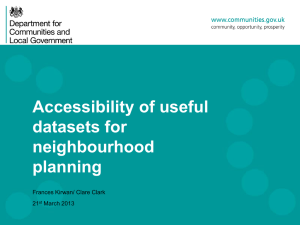
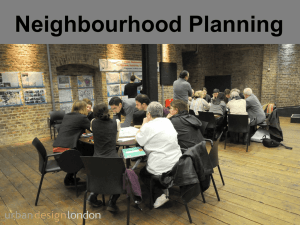


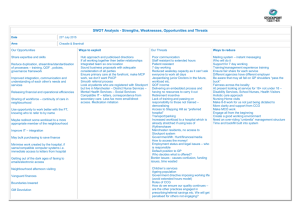

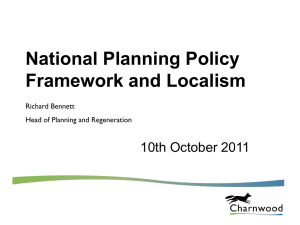

![MA3421 (Functional Analysis 1) Tutorial sheet 4 [October 23, 2014] Name: Solutions](http://s2.studylib.net/store/data/010731562_1-beb14263f14bdc19069992b7430e234b-300x300.png)

